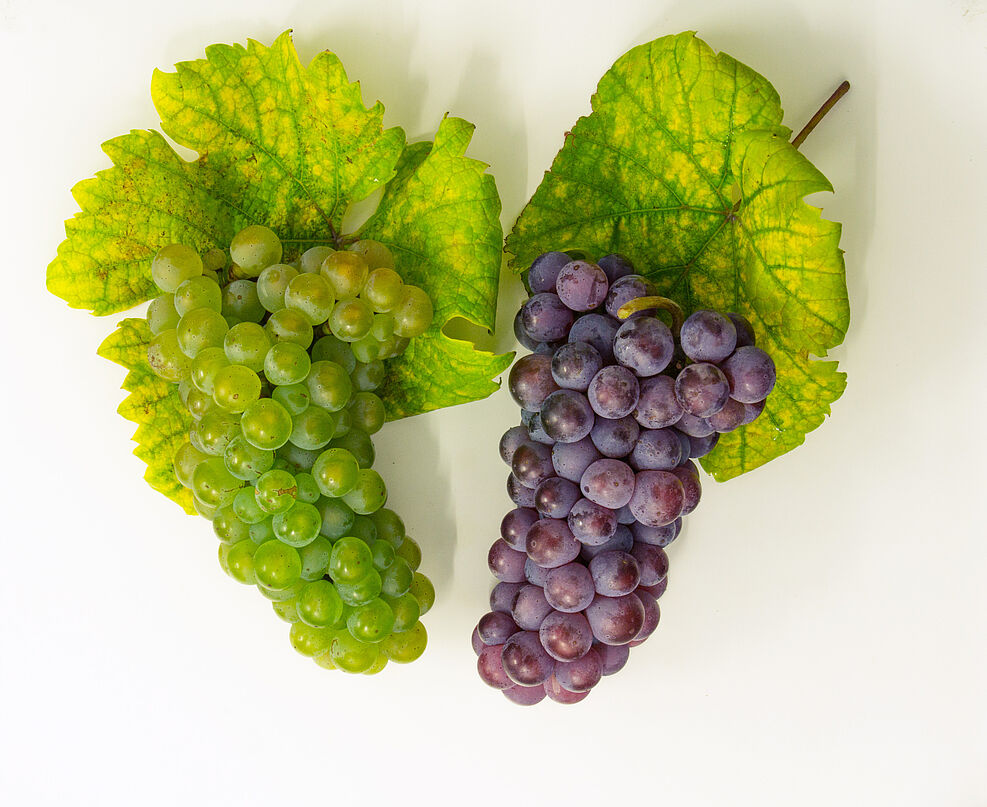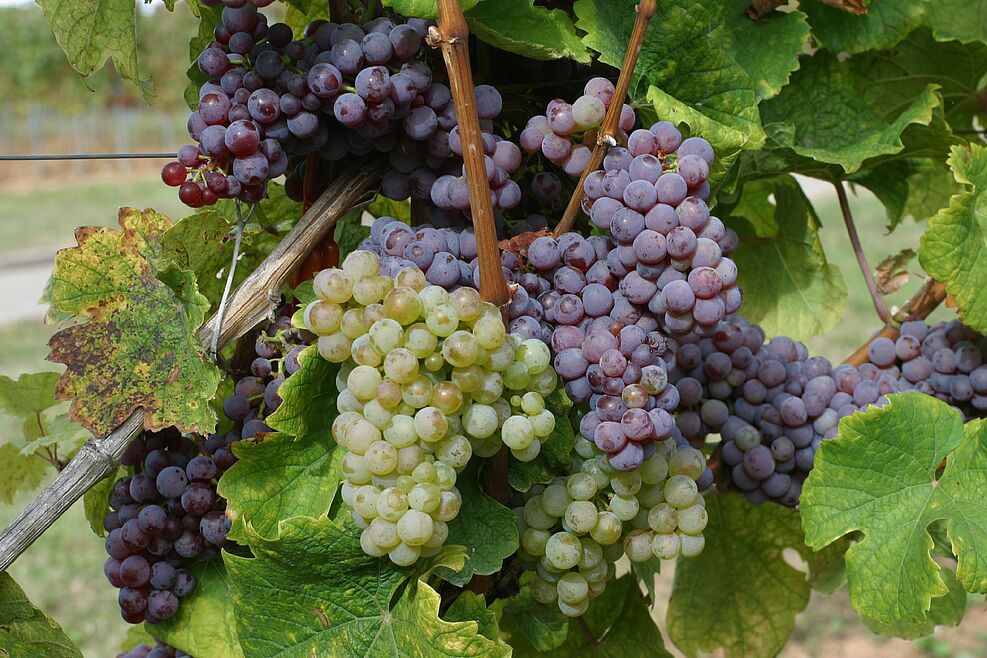Berry color locus of the Red Riesling variant located on the chromosome set of the white-berried parent White Heunisch
(Siebeldingen) The ancestors of today's cultivated grapevine varieties as well as almost all wild Vitis species have dark berries at the time of ripening. For a long time, breeders and scientists therefore assumed that the white-berried grapevine variety 'White Riesling' (RW), commonly referred to as 'Riesling', must have evolved from its red-berried twin 'Red Riesling'(RR). A study from the JKI Institute for Grapevine Breeding now refutes what experts expected to be true: "In the past, it was believed that the 'Red Riesling' represents the original grapevine variety. Especially since spontaneous mutations from red to white berries were observed again and again, but never vice versa," says Dr. Franco Röckel of the Julius Kühn Institute in Siebeldingen. "The examination of the chromosome sets (haplophases) of the 'Red Riesling` genome finally gave us certainty: the haplophase that leads to color in the red variety comes from the white-berried parent. Consequently, the mutation "red" must have happened in the 'White Riesling'".
The parents of the Riesling vine are the bright colored 'White Heunisch' and probably a seedling of 'Traminer' and V. sylvestris with unknown berry- color. Therefore, the red color could theoretically have had its roots in the unknown parent. The scientists at the Geilweilerhof site in Siebeldingen first investigated two genes (VvmybA1 and VvmybA2) known to regulate the coloration of dark berries. In white grapevine varieties, these gene segments are altered (mutated) and do consequently not form color pigments (mainly anthocyanin) in the berries at the beginning of ripening. However, the results of the PCR tests and sequencing of the 'Red Riesling' were surprising: neither of the two known genes VvmybA1 and VvmybA2 was responsible for the red color of the grapes.
In order to narrow down the unknown gene locus, Dr. Franco Röckel used self-fertilization to produce RW and RR seedlings (clones) whose color expression is identically coded on both chromosomes (homozygous alleles). Subsequent PCR tests then revealed a new product, which turned out to be a previously unknown VvmybA gene variant (VvmybA3/1RR). This gene variant is also capable of initiating color formation at berry ripening.
To clarify from which parent the mutated haplophase originates, the JKI scientist analyzed the homozygous RR progeny using SSR markers (so-called microsatellites). These characteristic gene sequences can in turn - like a genetic fingerprint - clearly be assigned to the RW parent 'White Heunisch'. According to this, VvmybA3/1RR must be the result from a mutation in 'White Riesling', since no comparable red color mutant has been described for Heunisch.
All of the approximately 17 'Riesling Red' clones examined in this study have the same mutation. The JKI researchers assume that the mutation in RR is stably conserved in the genome, underlined by the fact that no spontaneous mutation from white to red has been observed so far. However, the exact cause why 'Red Riesling' occasionally mutates back to white remains unexplained.
Publication:
Franco Röckel, Carina Moock, Florian Schwander, Erika Maul, Reinhard Töpfer and Ludger Hausmann (2022): A 69 kbp Deletion at the Berry Color Locus Is Responsible for Berry Color Recovery in Vitis vinifera L. Cultivar 'Riesling Rot'.
DOI: https://www.mdpi.com/1422-0067/23/7/3708
Background information on Riesling:
The grapevine variety 'Riesling' was first mentioned in 1435. However, there was no uniform spelling at that time, and the origin of the name is still being discussed today. A more recent thesis assumes that it derives from the 'soot spots', the conspicuous lenticels. Riesling probably originated in the Rhine valley between Karlsruhe and Worms. Today, it is the most widely cultivated grapevine variety in Germany, accounting for about 23 percent of total vineyard area (as of 2019).
For a long time, 'Red Riesling' had completely disappeared from cultivation for unknown reasons, but fortunately survived in German grapevine collections. In 1991, the Department of Grapevine Breeding in Geisenheim began conservation breeding work. Since then, more clones have been found in old vineyards. Since 2002, the cultivation of 'Red Riesling' has found its way back into practice. The demand of winegrowers is so high that experts expect the area under cultivation to increase by 50 ha in the coming years.
Scientific contact:
Dr. Franco Röckel
Julius Kühn Institute
Institute for Grapevine Breeding
Geilweilerhof, 76833 Siebeldingen, Germany
Phone: 06345 41-129
E-mail: franco.roeckel@julius-kuehn.de


